Did you know that Greco-Roman art was in colors?
Hello friends of Steemit, recently I found out that the ancient Greco-Roman art was in colors and it was something that left me quite impressed, that's why I wanted to write a post about it.
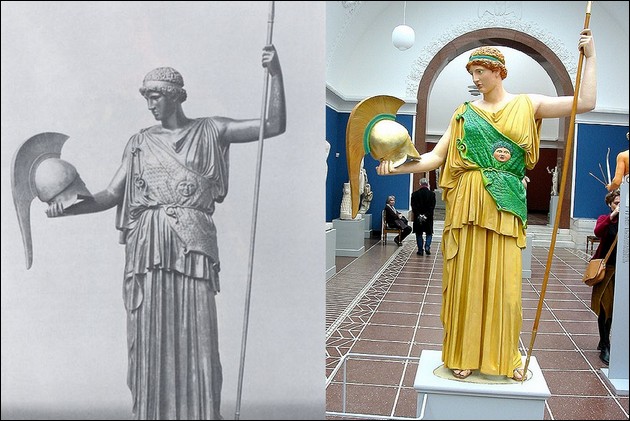
For hundreds of years it was considered that the ancient Greco-Roman white and light sculptures were the canon of beauty to follow, in fact, the color was totally suppressed during the Italian Renaissance (just remember the sculptures of Michelangelo or Donatello) and artists sought to imitate that aesthetic simplicity of the classics using white marble.
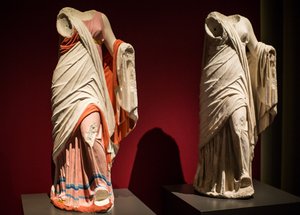)
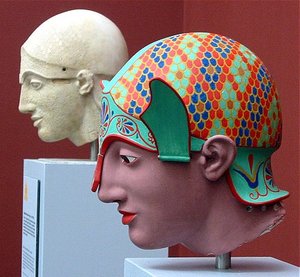
Our eyes and our brain are accustomed to seeing the classical Greco-Roman art of white color, of pure marble, however originally they were not like that, they were polychrome statues and structures, full of exuberant colors, that disappeared with the passage of time without leaving a trace.
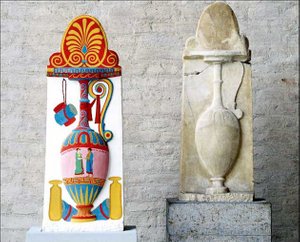)
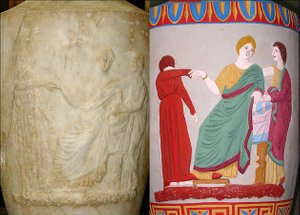)
In ancient times the colors were symbols of value, for example, in his statue found in Primaporta in the villa of his wife Livia, Emperor Augustus wears a red cloak that only he could wear (as a symbol of his military authority), including there were laws about what colors each person could use when dressing depending on their social status, for example, blue and purple were reserved for the nobility.
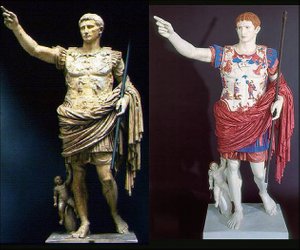)
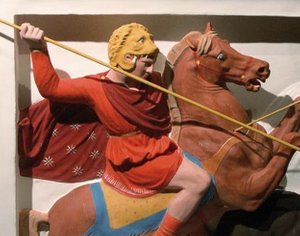)
The loss of color is mainly due to two reasons: the first because the natural pigments used in the making of the paintings were organic and secondly because most of them were outdoors, suffering from the inclemency of the weather.
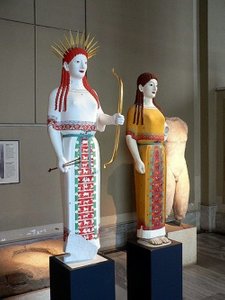)
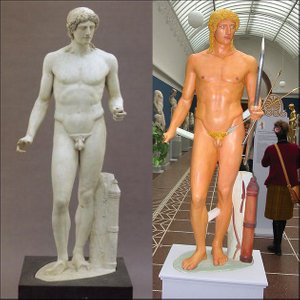)
Their polychromy is suspected because the sculptures found in pits in the ancient Acropolis preserved some of their colors and some ancient texts also assured this, like one by Platon in which it is stated that paint were applied to statues, especially the eyes that were the most beautiful, in order to achieve the beauty of the whole.
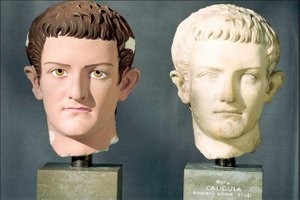)
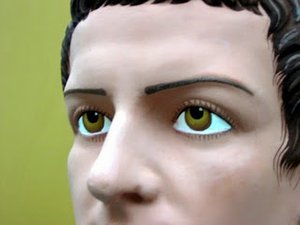)
Thus, since 1982, an international team of scientists (archaeologists, chemists, philologists), led by Vinzenz Brinkmann, director of the Collection of Antiquities of the Munich Museum and his wife Ulrike Koch-Brinkmann, has worked on various collections from places like Athens, Attica and the island of Aegina, with the purpose of being able to reconstruct the original color of the sculptures. This is done using laser equipment, ultraviolet light scans, infrared spectroscopy, microscopic examination and chemical analysis, looking for traces of pigments imperceptible to the human eye. Working for twenty years they have managed to rescue the true appearance of ancient art, showing us their original colors in molds painted by hand by Ulrike Koch-Brinkmann herself with the help of Sylvia Kellner and Kristine Siebert. The archeologists have looked for the maximum possible similarity with the original and before the doubt they have left colorless those areas where it has not could be obtain the suitable information. The figures also show replicas of their original ornaments, either in metal or or eyes with incrustations of glass and stone.
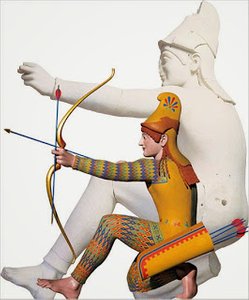)
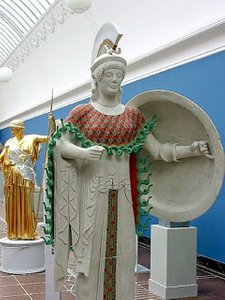)
These same reconstructions have been made with temples and structures, and this is how it was identified that the Parthenon was decorated with the colors blue, red, green and gold and also the sculptures made by Phidias that are found in the pediments, metopes and friezes were multicolored. Likewise, the roof of the porch of the Erechtheion (on the Acropolis of Athens) was painted in Egyptian blue.
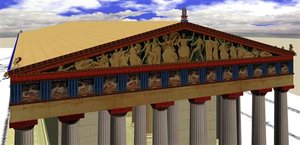)
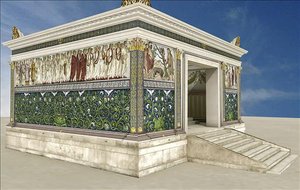)
Science really helped to recover a hidden information for hundreds of years and although I find it hard to get used to it, I have to admit that colors add humanity to the object, they contribute with much more detail and depth, however there are those who express their overwhelming rejection and consider an aberration the reconstruction in colors, finally, I would like to read your opinions about it.
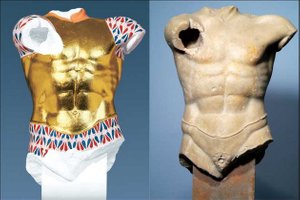)
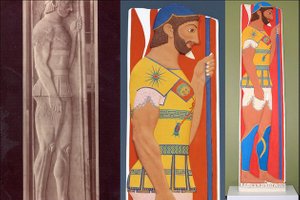)
I say goodbye until the next post.
Data of the review taken from:
- https://revistadehistoria.es/los-colores-originales-de-las-estatuas-griegas-y-romanas/
- http://almacendeclasicas.blogspot.com/2010/09/el-color-en-las-esculturas-griegas-y.html
- https://latunicadeneso.wordpress.com/tag/arte-griego-color/
- http://quhist.com/obras-arte-grecia-roma-con-colores-originales/

Well I personally think it makes perfect sense that statues of the antiquity were painted over, In fact I would even think they had much more lifelike pigments, at least those from the hellenistic period onward, if they went as far as they did to make perfect shapes on marble, why wouldn't they do the same effort with the pigments?
Totally agree, in fact at that time they love color, just that we get used to seeing them in white, thanks for your comment
I kinda have this theory, that the catholic church carried on with the cultural legacy of the old greco-roman world, albeit with many changes but if you look at the religious icons they are always very rich in colour and makes me think, if those are like that the old icons of the pre Christian period might have well been like that...
Y me acabo de dar cuenta que eres venezolana también y que puedo escribir en español. 😅
En fin si te fijas en la aureola que llevan todos eso iconos de santos y la virgen etc, eso viene de una tradición romana pagana, era para resaltar la divinidad en una representación, de hecho hay ejemplares de emperadores con ese elemento.
No había pensado en eso pero tienes razón, las imágenes católicas son muy coloridas, ahora pareciera tonto pensar que en realidad creíamos que las esculturas eran en mármol blanco sin ningún color...
Hi, two votes done for you
one for the post
and a rose gift to your comment
lovely roses to lovely friend
Upvoted from 200% to 300%
Good post
@red-rose like it
I HAVE UPVOTED THIS POST
ALSO RESTEEMED TO 675 FOLLOWERS.
GOOD WORK, I READ IT, I LIKED THE CONTENT AND PICTURES.

I WILL SHARE IT ON MY WEBSITE ON GOOGLE BLOG, G+,T,P, & MY FACE BOOK FAN PAG AFTER FEW DAYS.
THANK YOU
SAMER
RED-ROSE
Resteemed by @resteembot! Good Luck!
Curious?
The @resteembot's introduction post
Get more from @resteembot with the #resteembotsentme initiative
Check out the great posts I already resteemed.
I was very surprised when I learned this! I plan to work this idea into my upcoming graphic novel that centers on Socrates' trial and execution, and ancient Athens in general. I may use this page as a reference for my colorist!
It sounds interesting that novel, of course you can use the page :)
Awesome - thanks!
This post has received a 3.13 % upvote from @drotto thanks to: @eleyda78.
Well, that was a bit mindblowing. It's weird how certain things get lost in history.
I was shocked, but ..., things as they are, thanks for reading the post
@OriginalWorks
The @OriginalWorks bot has determined this post by @eleyda78 to be original material and upvoted it!
To call @OriginalWorks, simply reply to any post with @originalworks or !originalworks in your message!